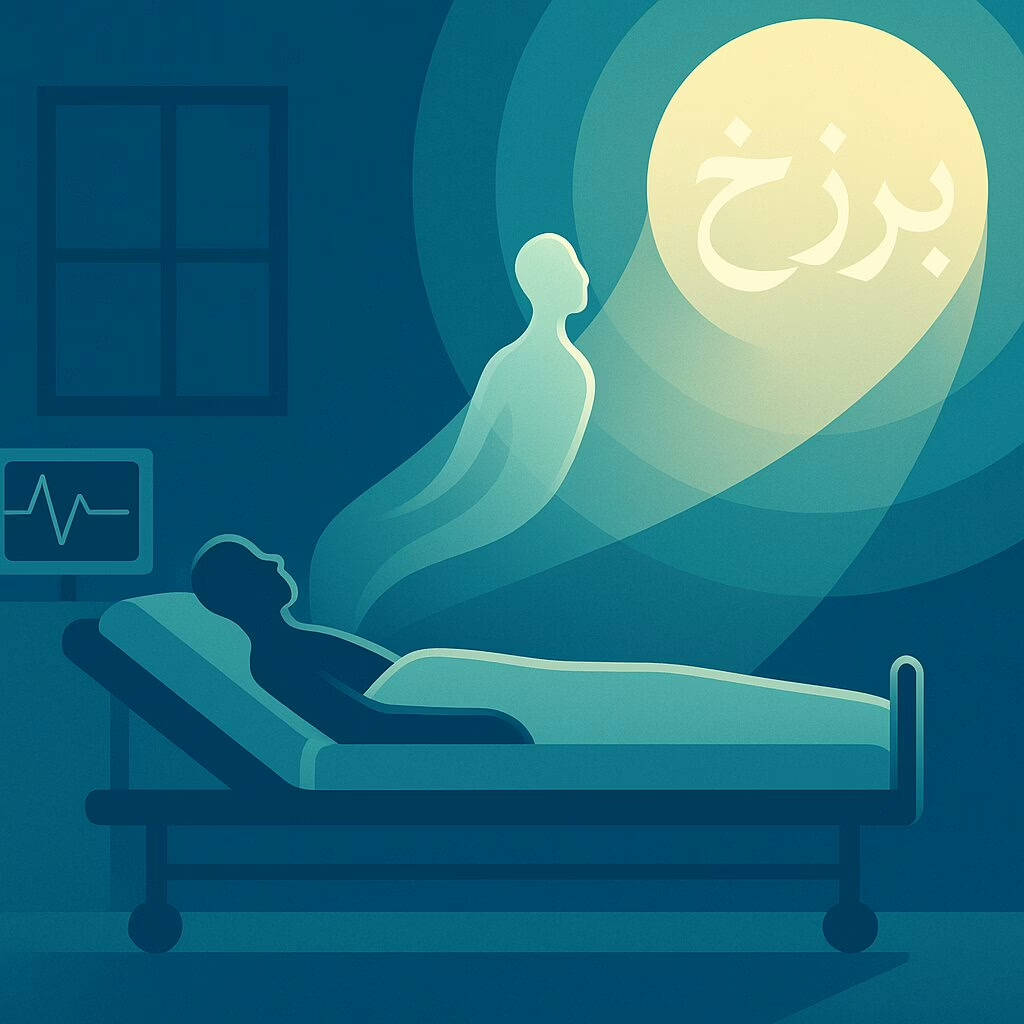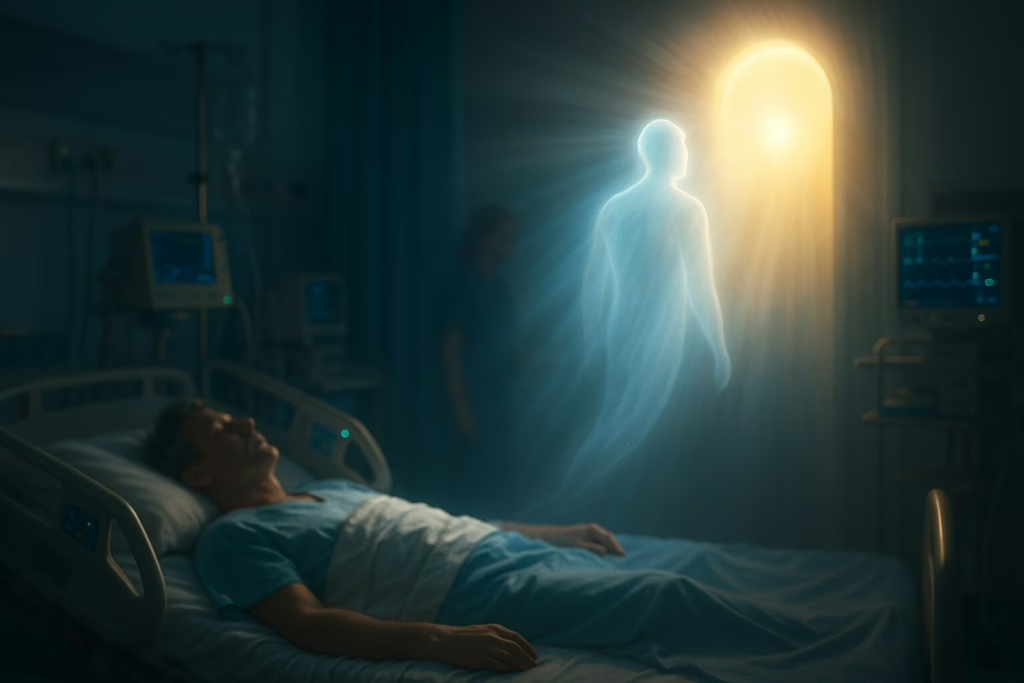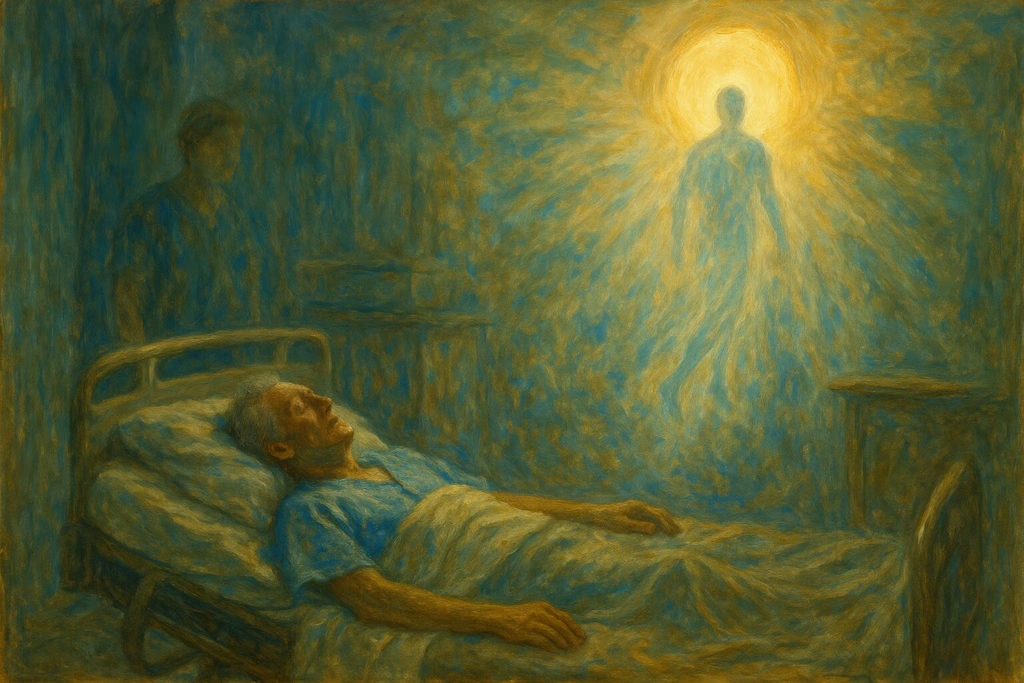This essay speaks to a broad audience; believers, seekers, skeptics alike. It weaves two strands: (1) the Qur’an’s account of death, the in-between realm (barzakh), and resurrection; and (2) modern research on Near-Death Experiences (NDEs).Islam teaches that death is a passage, not an ending. The self separates from the body, pauses in برْزَخ until resurrection, and faces the record of deeds. Near-death experiences describe the same arc, without crossing the final barrier. Those who do not cross may return, those who cross do not. وَمِنْ وَرَائِهِمْ بَرْزَخٌ إِلَى يَوْمِ يُبْعَثُونَ ۩
Core question in one sentence: Do near-death experiences fit the Qur’anic account of what happens between death and resurrection, and can people really “come back”?
Top intents:
- Understand how NDEs relate to برْزَخ in Islam.
- Weigh medical data and skeptical views against survivor reports.
- Clarify what, according to the Qur’an, can and cannot return.
“People were made for abiding”—and why many still fear extinction
A classical Syrian sage once sang:
“People were made for abiding—but a nation lost its way,
thinking we are made to vanish, to fade away.”
He meant: our intuition whispers continuity, yet many conclude that death is an absolute end. The Qur’an answers with a different voice—measured, direct, and tender, yet uncompromising about accountability:
وَمَنْ أَصْدَقُ مِنَ اللّهِ قِيلاً ۩
At life’s edge, many will plead:
حَتَّى إِذَا جَاءَ أَحَدَهُمُ الْمَوْتُ قَالَ رَبِّ ارْجِعُونِ ۩
لَعَلِّي أَعْمَلُ صَالِحًا فِيمَا تَرَكْتُ ۩
But the answer is sobering:
كَلَّا إِنَّهَا كَلِمَةٌ هُوَ قَائِلُهَا ۩
The moral texture is the point: when root character is corrupted, even a restart would repeat the same choices:
وَلَوْ رُدُّوا لَعَادُوا لِمَا نُهُوا عَنْهُ وَإِنَّهُمْ لَكَاذِبُونَ ۩
Across (المُؤمِنون) and الأنعام the message aligns: a barrier stands between death and resurrection:
كَلَّا إِنَّهَا كَلِمَةٌ هُوَ قَائِلُهَا وَمِنْ وَرَائِهِمْ بَرْزَخٌ إِلَى يَوْمِ يُبْعَثُونَ ۩
Until the trumpet is blown:
فَإِذَا نُفِخَ فِي الصُّورِ ۩

Wait—doesn’t the Qur’an also narrate people who died and returned?
It does, in multiple places—not as a loop-hole, but as lessons and signs:
أَلَمْ تَرَ إِلَى الَّذِينَ خَرَجُوا مِنْ دِيَارِهِمْ وَهُمْ أُلُوفٌ حَذَرَ الْمَوْتِ فَقَالَ لَهُمُ اللَّهُ مُوتُوا ثُمَّ أَحْيَاهُمْ ۩
And:
أَوْ كَالَّذِي مَرَّ عَلَى قَرْيَةٍ وَهِيَ خَاوِيَةٌ عَلَى عُرُوشِهَا قَالَ أَنَّى يُحْيِي هَذِهِ اللَّهُ بَعْدَ مَوْتِهَا فَأَمَاتَهُ اللَّهُ مِائَةَ عَامٍ ۩
… ثُمَّ بَعَثَهُ قَالَ كَمْ لَبِثْتَ ۩
Among the signs given to Jesus son of Mary was to raise the dead. And in the story of the heifer:
فَقُلْنَا اضْرِبُوهُ بِبَعْضِهَا كَذَٰلِكَ يُحْيِي اللَّهُ الْمَوْتَىٰ ۩
Another scene: a demand to “see God openly”—then the lightning strike:
وَإِذْ قُلْتُمْ يَا مُوسَى لَنْ نُؤْمِنَ لَكَ حَتَّى نَرَى اللَّهَ جَهْرَةً فَأَخَذَتْكُمُ الصَّاعِقَةُ وَأَنْتُمْ تَنْظُرُونَ ۩ ثُمَّ بَعَثْنَاكُمْ مِنْ بَعْدِ مَوْتِكُمْ لَعَلَّكُمْ تَشْكُرُونَ ۩
How do we reconcile these returns with the barzakh?
A two-stage model (from the Qur’an’s language)
When death arrives, two phases unfold:
- Separation: the self (النفس)—not the spirit in the technical Qur’anic sense—parts from the body. The self can, by God’s leave, be recalled before crossing the threshold. These are exceptional “returns.”
- Barzakh crossed: as (المُؤمِنون) phrases it, once beyond the barrier, return is barred until the Day of Rising:
وَمِن وَرَائِهِم بَرْزَخٌ إِلَىٰ يَوْمِ يُبْعَثُونَ ۩
This framework elegantly maps to what modern resuscitation and NDE research keep stumbling upon.
Near-Death Experiences (NDEs): a quick primer
Definition (modern): A cluster of perceptions reported by people who were clinically dead or near death—no heartbeat, no breathing, flatlined brain activity—and then revived. Common motifs: out-of-body perception, a tunnel or passage, overwhelming light, a panoramic life review, encounters with deceased loved ones, and a serene, non-fearful awareness.
Prevalence: In the U.S. alone, surveys have estimated well over ten million adults who report some form of NDE. The text you’re reading referenced estimates around fifteen million in the United States.
Resuscitation medicine: Journals like Lancet and the dedicated field of post-resuscitation care document that a significant minority of clinically dead patients are revived through CPR, defibrillation, cooling protocols, and critical-care advances—sometimes after startling durations. A consistent subset (often ~15%) report robust NDE narratives.
History of the term: Early researchers spoke of “imminent death experiences.” The term Near-Death Experience (NDE) was popularized by physician-philosopher Raymond Moody in Life After Life (1975), a landmark synthesis that gave the phenomenon a stable name.
Bottom line: Something real is happening at the edges of life. Whether you interpret it theologically or in strictly naturalistic terms, there is a signal in this noise.
قُلْ فَلِلَّهِ الْحُجَّةُ الْبَالِغَةُ فَلَوْ شَاءَ لَهَدَاكُمْ أَجْمَعِينَ ۩
Veridical perception: when “hallucination” doesn’t cut it
Skeptics often propose low oxygen (hypoxia), high carbon dioxide, temporal-lobe stimulation, ketamine-like states, or surges of endorphins and gamma activity. These mechanisms can induce some elements. But they don’t answer the most stubborn data point: veridical observations—accurate perceptions of events or objects the patient could not have sensed from the body.
Two examples recounted in the text:
- The “shoe on the ledge” case (documented by clinicians): A cardiac patient described leaving her body, floating outside the hospital, and noting a single shoe on a high window ledge near a specific office. A skeptical therapist went to check—no shoe in sight—until she climbed and felt with her hand on the ledge: the shoe was right there, exactly as described.
- Dentures & team actions (from a long Dutch multicenter study published in a major medical journal): A resuscitated elderly patient later identified who removed his dentures, which nurse took them, and where they were placed—details recorded while he was clinically dead.
When such accounts pile up, a candid scientist admits: data are outstripping our current model. Some researchers propose an “extended mind”—awareness that, at least in liminal states, is not confined to the brain’s ordinary processing.
يَوْمَ تَأْتِي كُلُّ نَفْسٍ تُجَادِلُ عَن نَّفْسِهَا ۩
What exactly leaves the body?
The Qur’an consistently speaks of النفس (the self) as what dies and departs, while الروح (the spirit) is a subtler God-breathed endowment:
وَنَفَخْتُ فِيهِ مِنْ رُوحِي ۩
The self is what argues, remembers, bears responsibility:
تُجَادِلُ عَن نَّفْسِهَا ۩
… يَوْمَ تَأْتِي كُلُّ نَفْسٍ تُجَادِلُ عَن نَّفْسِهَا ۩
A nimble couplet captures the mis-investment many of us make:
“O servant of the body—how hard you toil for clay,
Seeking profit where all accounts will fray.
Turn to the self, complete its virtues true;
You’re human by the soul—not the sinew.”
Children’s NDEs and moral responsibility
A striking research specialty: Near-Death Experiences in children. Pediatrician-researchers observed that children’s NDEs closely match adults’—with one consistent exception: no life review. In the source text this aligns beautifully with the Prophetic maxim that moral responsibility begins at maturity; before that, the “pen” does not record guilt. The author’s gratitude rings:
الْحَمْدُ لِلَّهِ الَّذِي هَدَانَا لِهَٰذَا وَمَا كُنَّا لِنَهْتَدِيَ لَوْلَا أَنْ هَدَانَا اللَّهُ لَقَدْ جَاءَتْ رُسُلُ رَبِّنَا بِالْحَقِّ ۩
لَقَدْ جَاءَتْ رُسُلُ رَبِّنَا بِالْحَقِّ ۩
وَمَنْ أَصْدَقُ مِنَ اللَّهِ حَدِيثًا ۩
… وَمَنْ أَصْدَقُ مِنَ اللَّهِ قِيلًا ۩
A revival after “zeroes across the monitor”
Critical-care physician Sam Parnia shares an emblematic case: Joe Tiralosi, who arrived in cardiac arrest. After prolonged CPR—thousands of chest compressions, multiple shocks, and cooling—he returned with a specific, structured NDE:
- He witnessed the medical team from an elevated vantage point, including distinctive hand motions.
- He encountered a luminous, compassionate presence “without mass and without shape”—aware of him, radiating love, dissolving fear.
- He came back transformed: less materialistic, more grateful and generous, more attuned to being a husband, father, and friend.
This profile of change—reduced fear of death, increased altruism—is widely reported among NDE survivors.

Raymond Moody’s simple thesis: death is transition
In public talks and in Life After Life, Moody observes that people liken death to:
- Breaking out of a prison (echoing a classical saying: “this world is a prison for the faithful”).
- Returning home—to a place strangely familiar.
The Qur’an sketches the same homeward guidance:
إِنَّ الَّذِينَ آمَنُوا وَعَمِلُوا الصَّالِحَاتِ يَهْدِيهِمْ رَبُّهُم بِإِيمَانِهِمْ تَجْرِي مِن تَحْتِهِمُ الْأَنْهَارُ ۩
A medieval poet wrote:
“Come, onward—Gardens everlasting call—
Our first true homes, with tents for all.
We’re captives still—will we, heart-whole,
Return at last and be made whole?”
Two appointments with death
The Qur’an hints at two appointments—one flexible, one fixed:
هُوَ الَّذِي خَلَقَكُم مِّن طِينٍ ثُمَّ قَضَىٰ أَجَلًا وَأَجَلٌ مُّسَمًّى عِندَهُ ۩
And:
وَمَا يُعَمَّرُ مِن مُّعَمَّرٍ وَلا يُنقَصُ مِنْ عُمُرِهِ إِلاَّ فِي كِتَابٍ ۩
Some returns happen before the sealed term; after the barzakh is crossed, there is no coming back “إِلَى يَوْمِ يُبْعَثُونَ.” Hence the remorse of those who only awaken too late:
قَالُوا رَبَّنَا أَمَتَّنَا اثْنَتَيْنِ وَأَحْيَيْتَنَا اثْنَتَيْنِ فَاعْتَرَفْنَا بِذُنُوبِنَا فَهَلْ إِلَىٰ خُرُوجٍ مِّن سَبِيلٍ ۩
And the broader arc:
كَيْفَ تَكْفُرُونَ بِاللَّهِ وَكُنتُمْ أَمْوَاتًا فَأَحْيَاكُمْ ثُمَّ يُمِيتُكُمْ ثُمَّ يُحْيِيكُمْ ثُمَّ إِلَيْهِ تُرْجَعُونَ ۩
A surgeon’s river, a light, and a choice
Neurosurgeon James R. Doty recounts: after a violent accident, he found himself conscious above his body, then gliding over a narrow river toward a radiant, non-hurting light—“the most loving presence” he had ever known. He sensed a truth: if he merged fully, he would not return. Seeing his life’s unfinished work and regrets, he cried out—not yet. He felt flung back—as if on a taut elastic band—and woke in this world with a new humility and a new aim.
The Qur’an had already drawn the regretful cry of those who postponed the obvious:
حَتَّىٰ إِذَا جَاءَ أَحَدَهُمُ الْمَوْتُ قَالَ رَبِّ ارْجِعُونِ ۩
Wisdom is to live now in a way that needs no such plea later.
A word for our age of noise
We live in a dizzying tizzy of information, hot takes, and designer doubt. Yet the NDE literature includes atheists, agnostics, and the indifferent—some emerge changed, some do not. The Qur’an names the tragedy with precision:
وَلَوْ رُدُّوا لَعَادُوا لِمَا نُهُوا عَنْهُ ۩
Freedom cuts both ways. The invitation remains—to become the kind of person who, if called tonight, would be ready, unafraid.
Older echoes: Plato’s “Myth of Er” and beyond
Even Plato’s Republic ends with a soldier who “dies” in battle, remains on the field days on end, and revives to report a vivid journey beyond. Whatever your reading of that tale, the human family keeps telling versions of the same story: the other shore is real.
وَإِنَّ الدَّارَ الْآخِرَةَ لَهِيَ الْحَيَوَانُ ۩
The Qur’an calls that life the Life—more vivid, expansive, and durable than this one.
Fire in the hills: an American rescuer’s NDE
One U.S. wildfire firefighter—call him Jake—described being overrun by flame as winds shifted. He perceived himself above his body. He saw (and spoke with) fellow firefighters also floating above their fallen forms. One colleague had a lifelong defect in his leg; in that lifted state Jake saw both legs perfect. The message—for those who can bear it—is that the self that leaves the body is not a material limb but the moral, conscious “I.”
At hospice bedsides, something similar sometimes appears: loved ones speak of doors opening, of welcomes extended by those who went before, as if a veil thins:
فَكَشَفْنَا عَنْكَ غِطَاءَكَ فَبَصَرُكَ الْيَوْمَ حَدِيدٌ ۩
The medical frontier: what NDE research actually says
Emergency rooms in the United States witness a growing cohort of patients who are resuscitated after prolonged cardiac arrest, thanks to rapid CPR, defibrillation, and targeted temperature management. Some of these survivors report classic near-death experiences: separation from the body, panoramic life review, beings of light, overwhelming peace, and accurate descriptions of scenes they should not have been able to see.
- A Dutch prospective study across 10 hospitals found that 18% of cardiac-arrest survivors reported NDEs, with lasting life changes years later. Methodology was careful, and follow-ups showed persistence of effects. thelancet.com
- The AWARE study led from the US and UK documented cognitive activity and even verifiable awareness in a subset of patients under resuscitation, suggesting consciousness may continue despite flatlined clinical signs. PubMed
- The widely discussed “shoe on the ledge” case, documented by the hospital social worker Kimberly Clark Sharp, remains one of the most cited veridical perception reports in the NDE literature. Elizabeth Whitworth
US medicine has built a subspecialty around post-resuscitation care, cooling devices such as Arctic Sun, and structured protocols to reduce brain injury and give the body time to reboot. Coverage in mainstream outlets has tracked how these advances push the boundary between life and death. The Atlantic
What this does not prove: medical data cannot “prove” the hereafter, only that under extreme conditions, experience sometimes includes features that look beyond the brain’s ordinary functioning.
Skeptics, materialists, and the “dying brain” model
Some neuroscientists propose that NDEs arise from hypoxia, neurochemical storms, or temporal-lobe discharges. Susan Blackmore lays out a clean version of this “dying brain hypothesis,” arguing that NDEs are constructed hallucinations. Dr Susan BlackmoreScientific American
The argument is worth hearing. Still, it struggles where reports include veridical details observed from vantage points no eyes could reach, and where aftereffects include long-term shifts in values and fearlessness about death that are not typical of simple hallucinations. The debate is ongoing, and thoughtful rebuttals exist within consciousness studies. PMCScience and Nonduality (SAND)
A philosopher blinks: when A. J. Ayer nearly died
The British logical positivist A. J. Ayer published “What I Saw When I Was Dead” after choking, arresting, and being revived in 1988. He did not convert, yet admitted the episode “slightly weakened” his confidence that death is the end. The point is not to overread his shift, only to observe that experience can soften axioms. philosopher.eu

Common motifs across NDE reports
- Separation and vantage: A felt exit from the body; seeing one’s form below, observing procedures and conversations from above or afar.
- The passage: Often a tunnel—what the Prophet called a miʿrāj (a vertical ascent)—dark at first, ending in a world-making light.
- The encounter: A Presence—loving, compassionate, intelligent—sometimes accompanied by familiar deceased loved ones or beings of trust.
- Panoramic life review: For morally responsible adults, a sweeping, instantaneous seeing of one’s acts—kindnesses and injuries, squandered chances and quiet gifts.
- The choice/command: “Not yet” or “If you go on, you cannot return.” Barzakh is a real boundary:
وَمِنْ وَرَائِهِمْ بَرْزَخٌ إِلَىٰ يَوْمِ يُبْعَثُونَ ۩
- Aftereffects: Reduced fear of death; increased empathy, generosity, truth-telling; a hunger to align one’s life with what matters.
Yes, some report distressing NDEs—fires, grotesque forms, predatory entities—usually after lives steeped in harm. Many reform; some do not.
When explanations retreat to “neural noise,” we can grant partial mechanisms and still ask the stubborn question: who is seeing from the ceiling? Material eyes are closed; instruments read zero. Yet the “I” continues to witness—coherent, moral, responsible.
Not everyone needs an NDE to trust the map
Many of us don’t require border-stories to believe that love, conscience, and accountability outlast the heartbeat. But perhaps these reports exist to remove excuses—to flood the hallway with enough light that no one can say, “I had no hint, no clue.”
A tender prayer for steadiness, from hearts that know how easily we drift:
لَا تُزِغْ قُلُوبَنَا بَعْدَ إِذْ هَدَيْتَنَا ۩
And a final, practical counsel: structure your days so that, if called this evening, you would greet the moment without panic—debts squared, bridges mended, small kindnesses done in the background where they count most.
Key Takeaways
- Two-stage death in the Qur’an: Separation of the self from the body (return sometimes granted), then barzakh, after which return is barred إِلَى يَوْمِ يُبْعَثُونَ.
- NDEs bridge faith and science: Medicine revives many; a consistent minority report structured, transformative experiences—including veridical observations.
- Life review signals moral reality: Adults commonly report a panoramic review; children typically do not—mirroring the tradition that moral responsibility begins at maturity.
- Common motifs: Out-of-body vantage, tunnel/light, loving presence, meeting loved ones, choice or command to return, durable character change.
- Live ready: The wisest use of NDE data is not argument, but alignment—so that when the call comes, no “رَبِّ ارْجِعُونِ” is needed
FAQ
Does Islam accept the idea of “coming back” after death?
Yes, before the final barrier. The Qur’an itself gives examples of revival. After برْزَخ, return is closed إِلَى يَوْمِ يُبْعَثُونَ ۩.
Are NDEs proof of the afterlife?
They are not proof in a lab sense. They are evidence of experiences that resist simple brain-only explanations. thelancet.comPubMed
Why do many NDEs report a tunnel and light?
Whether you call it a tunnel or معراج, survivors describe a transition, often toward a compassionate light.
What about “life review”?
It aligns with moral accountability. يَوْمَ تَأْتِي كُلُّ نَفْسٍ تُجَادِلُ عَن نَّفْسِهَا ۩. Studies report transformative aftereffects. thelancet.com
So, do the dead speak?
They do not phone home from برْزَخ. Yet those who have not crossed can return and tell of separation, presence, and responsibility.
Conclusion
Between the ICU monitors and the immortal address of revelation stands a human being who will answer for a life. Some people flatline, separate, glimpse, and return with kinder eyes. Others cross the barrier and wait for the Trumpet. Read the signs, live with purpose, and meet death without flinching. وَمَنْ أَصْدَقُ مِنَ اللَّهِ قِيلًا ۩
Sources
- Pim van Lommel et al., “Near-death experience in survivors of cardiac arrest,” The Lancet 2001. thelancet.com
- Sam Parnia et al., “AWARE, Awareness during Resuscitation,” Resuscitation 2014. PubMed
- Kimberly Clark Sharp, “Maria’s shoe” case overview. Elizabeth Whitworth
- Christof Koch, “What Near-Death Experiences Reveal about the Brain,” Scientific American. Scientific American
- Susan Blackmore, Dying to Live chapter, and overview of the dying-brain model. Dr Susan Blackmore
- A. J. Ayer, “What I Saw When I Was Dead” summary page. philosopher.eu
- Plato’s Myth of Er, concise references. WikipédiaThoughtCo
- Post-resuscitation care context and public reporting. The Atlantic
- Miracles from Heaven background. HistoryvsHollywood.comPeople.com
- Rupert Sheldrake on the extended mind, for context in the broader debate. Rupert Sheldrake – Author and Biologist
